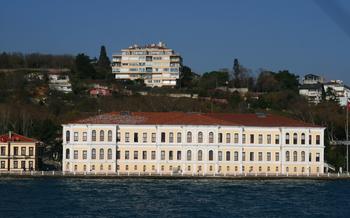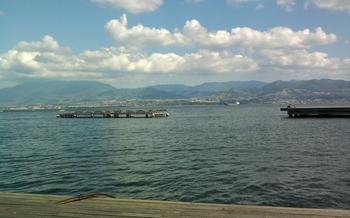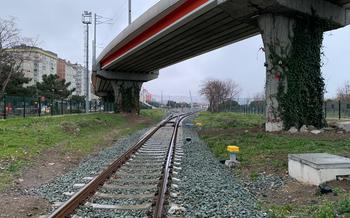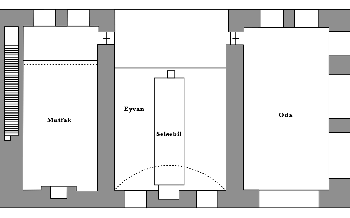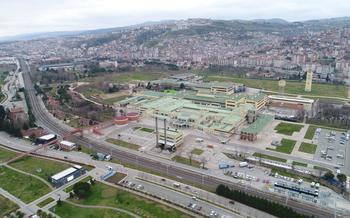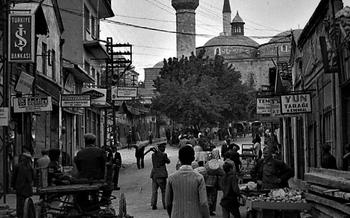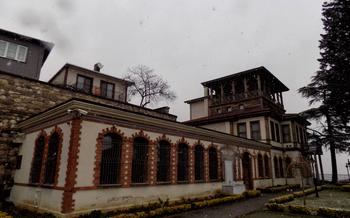
Kapanca Sokak and Historical Houses
- History of the Street
- Architectural Significance
- Cultural Importance
- Historical Houses: A Glimpse into the City's Past
- Exploring Kapanca Sokak: A Walking Tour
- The Story Behind the Names: Kapanca and Historical Houses
- Historical Houses: A Symbol of Resilience
- Historical Houses: A Glimpse into Daily Life
- Historical Houses: A Source of Inspiration
- Historical Houses: A Link to the Past
- Historical Houses: A Symbol of Community
- Insider Tip: Hidden Treasures
History of the Street
Kapanca Sokak, a narrow cobblestone street in the heart of İzmit, Turkey, holds a rich history that dates back to the Ottoman Empire. The street, which translates to "Covered Market Street," was once a bustling center of commerce, lined with shops and stalls selling a variety of goods. Over the centuries, Kapanca Sokak has undergone transformations, reflecting the changing times and influences in the city. Despite the passage of time, the street has retained its charm and historical significance, making it a popular destination for both locals and tourists.
Architectural Significance
The architectural heritage of Kapanca Sokak is a testament to the diverse influences that have shaped İzmit's history. The street is lined with a mix of Ottoman-era buildings, characterized by their intricate tilework, arched windows, and wooden balconies, as well as more modern structures that reflect the city's transformation in the 20th century. The juxtaposition of these architectural styles creates a unique and visually appealing streetscape that captures the essence of İzmit's past and present.
Cultural Importance
Kapanca Sokak holds immense cultural significance for the people of İzmit. The street has long been a gathering place for locals, a place to trade, socialize, and celebrate. It has witnessed countless historical events, festivals, and celebrations, becoming an integral part of the city's cultural fabric. The street's vibrant atmosphere and rich history make it a beloved destination for residents and visitors alike, who come to experience the unique charm and authenticity of this historic thoroughfare.
Historical Houses: A Glimpse into the City's Past
The historical houses lining Kapanca Sokak are a testament to İzmit's rich history and architectural heritage. Built in the late 19th and early 20th centuries, these houses showcase a diverse range of architectural styles, from traditional Ottoman to European-influenced designs. Many of the houses feature intricate stone carvings, decorative facades, and beautifully preserved wooden balconies.
These historical houses played a significant role in the city's development. They were once home to wealthy merchants, influential families, and prominent figures who shaped İzmit's social and economic landscape. Today, some of these houses have been converted into museums, art galleries, and cultural centers, offering visitors a glimpse into the city's past and the lives of its former residents.
Anecdote: A story about a historical figure who lived in one of the houses
One of the most famous historical figures associated with Kapanca Sokak is the renowned Turkish author and playwright, Ömer Seyfettin. Seyfettin lived in one of the historical houses on the street during his time in İzmit. The house, now known as the Ömer Seyfettin House Museum, has been preserved as a memorial to the writer's life and work. Visitors can explore the museum and learn about Seyfettin's contributions to Turkish literature, gaining insights into the cultural and intellectual atmosphere of İzmit during his time.
Exploring Kapanca Sokak: A Walking Tour
To fully experience the charm of Kapanca Sokak, embark on a leisurely walking tour. Start your journey at the intersection of Fevzi Çakmak Caddesi and Kapanca Sokak, where you'll find the iconic clock tower. From here, stroll along the cobblestone street, admiring the architectural wonders that line both sides.
As you wander, be sure to take note of the intricate carvings and decorative elements that adorn the historical houses. Each house has its unique story to tell, showcasing the architectural styles and influences that have shaped Izmit over the centuries.
Along the way, you'll encounter several points of interest that are worth exploring further. Visit the Kapanca Hamam, a historical bathhouse that has been beautifully restored and now serves as a cultural center. Don't miss the opportunity to step inside and admire the stunning tilework and architecture.
Continue your walk and you'll come across the Izmit Archaeological Museum, which houses a fascinating collection of artifacts from the region's rich history. Take some time to browse the exhibits and learn about the ancient civilizations that once called Izmit home.
For a break from history and culture, stop by one of the many charming cafes or restaurants that line Kapanca Sokak. Indulge in a traditional Turkish coffee or tea, and savor the flavors of local cuisine while soaking up the vibrant atmosphere of the street.
As you approach the end of Kapanca Sokak, you'll find yourself at the picturesque waterfront. Take a moment to admire the stunning views of the Gulf of Izmit and the surrounding mountains. This is the perfect spot to end your walking tour and reflect on the rich history and cultural heritage you've experienced along the way.
The Story Behind the Names: Kapanca and Historical Houses
The name Kapanca Sokak derives from the Turkish word "kapanca," meaning "trap" or "snare." According to local legend, the street was named after a cunning thief who used to set traps for unsuspecting victims. The thief would hide in the narrow alleyways and wait for passersby to walk by. When someone came close, he would spring his trap and rob them of their belongings.
The historical houses along Kapanca Sokak have their own unique stories and names. Many of the houses are named after their former owners or the families who lived in them for generations. For example, one house is known as the "House of the Merchant" because it was once owned by a wealthy merchant who traded goods from all over the world. Another house is called the "House of the Doctor" because it was once home to a renowned physician who served the community for many years.
These names not only provide a glimpse into the history of the street and its residents but also add to its charm and character. They serve as a reminder of the people who have lived and worked in Kapanca Sokak over the centuries and the stories that their walls could tell.
Historical Houses: A Symbol of Resilience
Despite various historical events, including fires, earthquakes, and wars, many of the historical houses in Izmit have survived and continue to stand tall. Their endurance is a testament to their sturdy construction and the dedication of local communities to preserving their cultural heritage.
The houses have undergone restoration and preservation efforts over the years, ensuring their longevity. In some cases, the original architectural features and details have been painstakingly restored, preserving the authenticity of these historic structures.
Preserving these historical houses is of utmost importance, as they serve as tangible links to the past and provide invaluable insights into the city's history, culture, and traditions. They remind us of the resilience and determination of the people of Izmit, who have overcome adversity to protect their heritage.
Anecdote:
In the heart of Izmit, stands a historical house that has defied the odds. It survived the devastating fire of 1923, which destroyed much of the city. The house bears visible scars from the fire, but its structure remains strong.
The current owner, Mr. Ahmet, lovingly restored the house, using traditional techniques and materials. He discovered hidden architectural features during the restoration, such as intricate carvings and colorful tiles, which he carefully preserved.
Mr. Ahmet believes that these historical houses are more than just buildings; they are living witnesses to the city's rich history. He is proud to be a part of preserving this legacy for future generations.
Historical Houses: A Glimpse into Daily Life
The historical houses of Kapanca Sokak offer a fascinating glimpse into the daily life of Izmit's residents in the past. The architectural features of these houses, such as the spacious courtyards, iwans (vaulted halls), and intricate woodwork, reflect traditional lifestyles that were closely tied to family and community.
Stories abound of everyday life in these houses. In the past, extended families often lived together under one roof, creating a vibrant and bustling atmosphere. Women would gather in the courtyard to socialize, cook, and care for children, while men would conduct business and entertain guests in the formal reception rooms. The courtyards also served as a place for children to play and for families to gather for celebrations and special occasions.
In contrast to the modern lifestyle, where people often live in smaller apartments or houses and spend much of their time outside the home, the historical houses of Kapanca Sokak offer a glimpse into a time when life was centered around the home and community.
Anecdote:
A local resident, Ayşe Teyze, shared a story about her childhood in one of the historical houses on Kapanca Sokak. She recalled how her family would gather in the courtyard in the evenings, sharing stories and laughter. Her grandmother would prepare traditional Turkish dishes in the outdoor kitchen, and the family would eat together on a large communal table. Ayşe Teyze remembers feeling a sense of warmth and belonging as she grew up in this close-knit community.
Historical Houses: A Source of Inspiration
The historical houses of Kapanca Sokak have served as a source of inspiration for numerous famous individuals throughout history. Writers, artists, and musicians have all found their creative spark ignited within the walls of these ancient dwellings. One such example is the renowned Turkish writer Ahmet Hamdi Tanpınar, who spent his childhood in a historical house on the street. The beauty and charm of the house, as well as the stories of its former inhabitants, left a lasting impression on Tanpınar's imagination and influenced his literary works. His novel Huzur (Peace), set in a historical house similar to the one he grew up in, is considered a masterpiece of Turkish literature and a testament to the power of these houses to inspire creativity.
Historical Houses: A Link to the Past
Preserving historical houses for future generations is essential for several reasons. Firstly, these houses are valuable historical artifacts that provide insights into the past, helping us understand the evolution of architecture, culture, and society. Secondly, historical houses serve as educational tools, enabling us to learn about different periods in history and the lives of people who lived in these houses. Thirdly, historical houses contribute to cultural tourism, attracting visitors interested in exploring the heritage of a particular region.
Preserving historical houses, however, comes with challenges. One significant challenge is the cost of restoration and maintenance. These houses often require specialized expertise and materials, making their upkeep expensive. Another challenge is the need to balance preservation with modernization. While it is important to maintain the historical integrity of these buildings, they also need to be adapted to meet contemporary needs and standards.
Despite these challenges, preserving historical houses is crucial for maintaining our connection to the past and ensuring that future generations can appreciate and learn from these architectural treasures. By working together, communities, governments, and organizations can overcome these challenges and successfully preserve our historical heritage.
Historical Houses: A Symbol of Community
In the heart of Kapanca Sokak, historical houses stand as testaments to the enduring spirit of community. These structures have witnessed generations of families living side by side, sharing joys and sorrows, and forging unbreakable bonds. Neighbors have come together to celebrate festivals, support each other in times of need, and preserve their shared heritage.
One such story is that of the annual neighborhood festival organized by the residents of Kapanca Sokak. Every year, they gather in the street, transforming it into a vibrant marketplace filled with traditional Turkish cuisine, music, and dance. Neighbors set up stalls selling handmade crafts, local delicacies, and vintage items, creating a lively atmosphere that brings the community together.
Another example of community spirit is the collaborative effort to restore and maintain the historical houses. When one of the houses was in danger of collapsing, the neighbors rallied together to raise funds and organize a restoration project. They worked tirelessly, sharing their skills and resources, and eventually brought the house back to its former glory. The restored house now serves as a community center, hosting events, workshops, and exhibitions that celebrate the rich history and culture of Kapanca Sokak.
These stories highlight the importance of historical houses as symbols of community. They are not just physical structures but also spaces where people come together, share experiences, and create lasting memories. Preserving these houses is not just about protecting the past but also about fostering a sense of belonging and community spirit that will endure for generations to come.
Insider Tip: Hidden Treasures
Kapanca Sokak and its surroundings are home to several hidden treasures that are worth exploring. One such gem is a small courtyard tucked away between two historical houses. To find it, look for a narrow alleyway leading off the main street. The courtyard is a tranquil oasis, with a fountain, colorful flowers, and a seating area. It's the perfect place to escape the hustle and bustle of the city and enjoy a moment of peace and quiet.
Another hidden gem is a rooftop terrace overlooking the street. To access it, you'll need to climb a narrow staircase hidden behind a wooden door. The terrace offers stunning views of the historical houses and the surrounding neighborhood. It's a great place to relax and take in the sights and sounds of the city.
To explore Kapanca Sokak like a local, I recommend visiting in the early morning or evening when the street is less crowded. This will give you a chance to appreciate the architecture and atmosphere of the street without the crowds. You'll also be able to find some great photo opportunities without having to wait for people to move out of the way.
No matter when you visit, Kapanca Sokak is a street that's full of surprises. Keep your eyes open and you're sure to discover some hidden treasures of your own.
